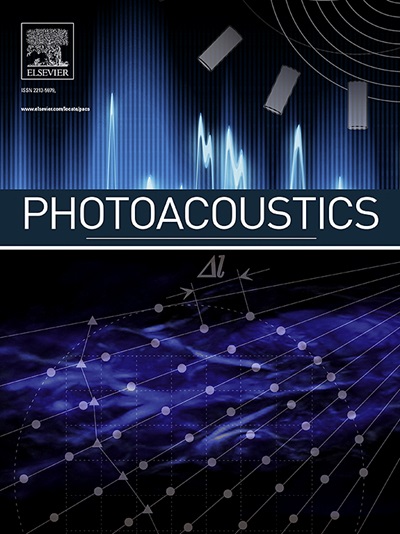评估脂质体载体的生物分布、稳定性和清除的多模式方法
IF 6.8
1区 医学
Q1 ENGINEERING, BIOMEDICAL
引用次数: 0
摘要
正在研究用于特定部位药物递送的脂质体载体,通过用成像造影剂替代治疗方法作为诊断方法,探索选择性治疗计划的潜力。对于脂质体载体的生物分布、稳定性和清除动力学的体内评估仍有迫切的需要。本初步研究提出了一种多模式方法,其中脂质体封装的j聚集吲哚菁绿(ICG)染料(脂质体-JICG)使用体内光声(PA)成像以高空间分辨率成像,以评估JICG和单体ICG的吸光度特征,并使用体外冷冻荧光断层扫描(CFT)测量ICG荧光。体外比较lipoo - jicg与ICG的吸光度与荧光关系发现,随着lipoo - jicg:ICG比值的增大,吸光度峰从780 nm移至895 nm;同时,随着lipoo - jicg:ICG比例的增加,荧光急剧下降,说明j聚集猝灭了荧光。然后在注射前对12只小鼠进行PA成像,然后在注射lipoo - jicg后长达6天。未混合的lipog - jicg信号在注射后30 min达到峰值;未混合的ICG信号在注射后达到峰值,随着时间的推移在两个器官中减弱,在6天时在脾脏中增加。在CFT中,ICG荧光也有类似的变化趋势,在肝脏和脾脏中,ICG荧光在30 min和6 d时达到最大值,这表明在注射后6 d, lipoo - jicg继续通过肝脏系统分解和排泄。未来的研究将继续发展这种方法,以评估载瘤小鼠模型中脂质体载体的生物分布、稳定性和清除率。本文章由计算机程序翻译,如有差异,请以英文原文为准。
A multimodal approach to assess a liposomal carrier’s biodistribution, stability, and clearance
Liposomal carriers, used for site-specific drug delivery, are being investigated for diagnostic approaches by replacing the therapeutic with an imaging contrast agent, exploring potential for selective treatment planning. There remains a critical need to improve in vivo assessment of biodistribution, stability, and clearance kinetics of liposomal carriers. This pilot study presents a multimodal approach in which liposome-encapsulated J-aggregated indocyanine green (ICG) dye (Lipo-JICG) is imaged with high spatial resolution using both in vivo photoacoustic (PA) imaging, to assess the absorbance characteristics of JICG and monomeric ICG, and ex vivo cryofluorescence tomography (CFT), to measure ICG fluorescence. An in vitro assay comparing the relationship between absorbance and fluorescence of Lipo-JICG and ICG demonstrated that the absorbance peak shifted from 780 to 895 nm as the Lipo-JICG:ICG ratio increased; meanwhile, the fluorescence decreased drastically as the Lipo-JICG:ICG ratio increased, demonstrating that J-aggregation quenches fluorescence. Twelve mice were then PA imaged pre-injection, then up to 6 days after Lipo-JICG injection. Unmixed Lipo-JICG signal peaked at 30 min post-injection in both liver and spleen; unmixed ICG signal peaked post-injection, decreasing over time in both organs and increasing at 6 days in the spleen. With CFT, ICG fluorescence followed a similar trend, with a maximum at 30 min in liver and at 6 days in spleen, implying that Lipo-JICG continued to break down and excrete through the hepatic system over 6 days post-injection. Future studies will continue to develop this methodology to assess biodistribution, stability, and clearance of liposomal carriers in tumor-bearing murine models.
求助全文
通过发布文献求助,成功后即可免费获取论文全文。
去求助
来源期刊

Photoacoustics
Physics and Astronomy-Atomic and Molecular Physics, and Optics
CiteScore
11.40
自引率
16.50%
发文量
96
审稿时长
53 days
期刊介绍:
The open access Photoacoustics journal (PACS) aims to publish original research and review contributions in the field of photoacoustics-optoacoustics-thermoacoustics. This field utilizes acoustical and ultrasonic phenomena excited by electromagnetic radiation for the detection, visualization, and characterization of various materials and biological tissues, including living organisms.
Recent advancements in laser technologies, ultrasound detection approaches, inverse theory, and fast reconstruction algorithms have greatly supported the rapid progress in this field. The unique contrast provided by molecular absorption in photoacoustic-optoacoustic-thermoacoustic methods has allowed for addressing unmet biological and medical needs such as pre-clinical research, clinical imaging of vasculature, tissue and disease physiology, drug efficacy, surgery guidance, and therapy monitoring.
Applications of this field encompass a wide range of medical imaging and sensing applications, including cancer, vascular diseases, brain neurophysiology, ophthalmology, and diabetes. Moreover, photoacoustics-optoacoustics-thermoacoustics is a multidisciplinary field, with contributions from chemistry and nanotechnology, where novel materials such as biodegradable nanoparticles, organic dyes, targeted agents, theranostic probes, and genetically expressed markers are being actively developed.
These advanced materials have significantly improved the signal-to-noise ratio and tissue contrast in photoacoustic methods.
 求助内容:
求助内容: 应助结果提醒方式:
应助结果提醒方式:


